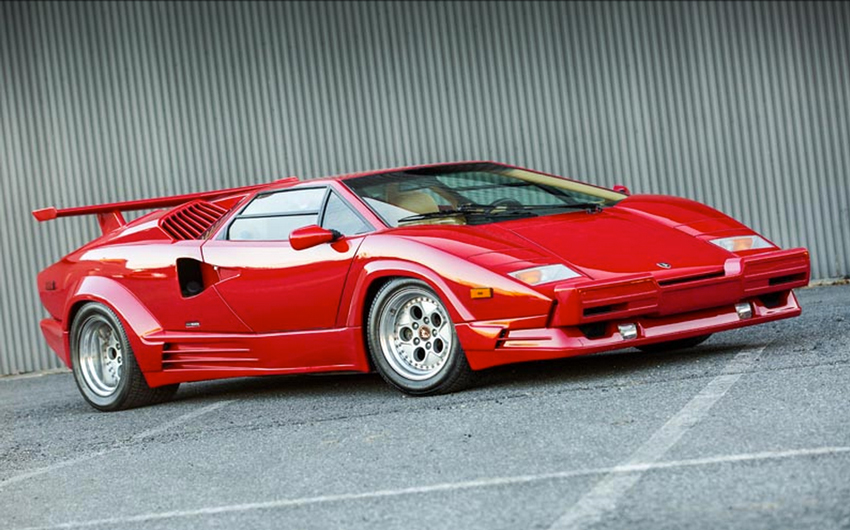Media | Articles
Is the Lamborghini Diablo finally stepping out of the Countach’s shadow?
The March 1966 debut of the Lamborghini Miura set the tiny Italian speed salon on the path it follows today: purveyor of outlandish mid-engine attention hogs, built for the most dedicated extroverts. The Miura begat the Countach, which begat the Diablo, which begat the subsequent Murcielago and Aventador, as Lamborghini steadily departed from its founder’s original plan of producing faster and better GT cars than his rival in Maranello. Instead, Lamborghini has been focused for the past 50 years on trying to one-up itself with increasingly more freakish two-seat screamers.
And while the Miura was a tough act to follow, Bertone chief designer Marcello Gandini succeeded with the 1974 LP400 Countach. The 150 examples of this original “periscopo” Countach, so nicknamed for a periscope-style roof-mirror concept which was intended but never realized in production, now routinely trade for more than $1 million. Later Countaches have also picked up in recent years, with the LP5000 S of 1982–85 and the four-valve, 455-hp LP 5000 QV (for Quattrovalvole) of 1985–88 reliably trading for somewhere between $250,000 and a half-million. Examples of the final Countach, the strake-smeared 1988–90 25th Anniversary Edition, of which 650 were made, can be found for less than $200,000, though mileage and overall condition are big factors.
20180105215540)

Long lurking in the Countach’s wedgy shadow has been its successor, the 1991–2001 Diablo. Again, Lamborghini tried to outdo itself with an incredibly wide and aggressively macho design. But the constraints of new safety and emissions regulations and the smoothing hand of actual wind tunnel work—a new concept in aerodynamic efficiency for Lamborghini—are evident in the rounded bumpers and softer features. Lamborghini’s then-owner, Chrysler Corporation, which purchased the company in 1987, wanted the Diablo to emerge as fuel-efficient as possible for a car with a 492-hp V-12 and fully legal for sale in every major market, something the Countach never was.
However, while Countach prices have slipped significantly, losing about 24 percent in the past year, Hagerty data shows Diablo average values gaining almost 18 percent in the same period. A few Diablo sales at Scottsdale prove that Lamborghini’s 202-mph size-EEE super-wedge has likely bottomed out and is finally on the upswing. Prices that had over the past decade slipped under $100,000 are now comfortably over that mark, with the cleaner examples going for closer to $200,000. A red, 2236-mile ’91 traded in Scottsdale for $190,400, while a white 1991 model with the early unloved dash—but with less than 600 miles showing, one owner for the past 25 years, and the rare optional Breguet chronometer, a $10,500 bauble fitted to just 21 Diablos—gaveled at $217,250 at Gooding & Company. We’re betting this same car will fetch a much higher price in a short time, as unmodified, low-mileage Diablos (in non-crazy colors) can be hard to find.
Marketplace
Buy and sell classics with confidence
20180125180101)
20180125180446)
20180125180452)
20180125180458)
Lamborghini’s first computerized car has a well-earned reputation as a money pit, especially as the internally developed LIE engine management computers are all but unobtainable and problems with them have forced many an owner to swallow expensive solutions such as converting the cars to run on aftermarket MoTec controllers.
Then there’s the rubber in the bushings and engine mounts, which never last more than a few years. And the fact that you have to pull the engine to replace the starter. And the heavy and clunky all-wheel-drive hardware on VT models that many owners rip out.
Still, Diablo sellers seem to be bullish and willing to wait for buyers to pay their price. Of five Diablos offered in Scottsdale, two were no-sales, including a black ’92 with 26,839 miles that stalled at $125,000, and a 2001 VT 6.0 that peaked at $260,000. Earlier auctions in 2017 show a number of no-sales as Diablo owners wait for more buyers to wake up to the awesomeness of Lamborghini’s scissor-door V-12 devil.

20180125180437)









